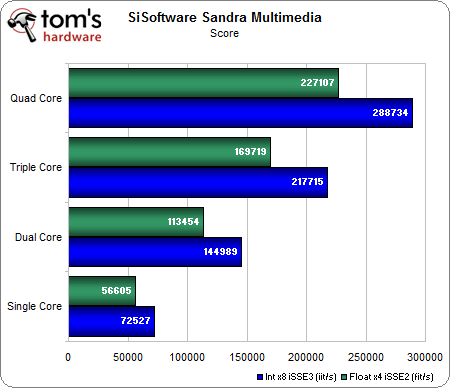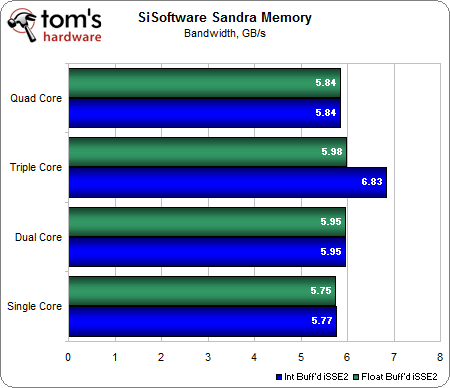How Many CPU Cores Do You Need?
Synthetic Benchmarks: SiSoft Sandra
We'll begin with SiSoft Sandra's CPU arithmetic and CPU multimedia benchmarks:
These synthetic benchmarks are showing us a very linear progression between one to four CPU cores. Frankly, this benchmark software is written in a way to utilize multiple cores very efficiently, but I doubt many real-world applications are going to be able to duplicate this linear progression.
Sandra's memory benchmark suggests that three cores will be more memory bandwidth friendly when it comes to integer buffered iSSE2 operations.
Synthetics have their place, but let's get into the meat and potatoes of this review: application benchmarks.
Get Tom's Hardware's best news and in-depth reviews, straight to your inbox.
Current page: Synthetic Benchmarks: SiSoft Sandra
Prev Page Synthetic Benchmarks: 3DMark And PCMark Vantage Next Page Application Benchmarks: Audio EncodingDon Woligroski was a former senior hardware editor for Tom's Hardware. He has covered a wide range of PC hardware topics, including CPUs, GPUs, system building, and emerging technologies.
-
SpadeM Good piece, this will probably clear up some misunderstandings about dual vs. quad core processors. With just a clarification, that this article is based on the same clock speed (2.7Ghz) for ALL processor cores. And so, in some cases where the software isn't optimized for a multi core experience then going up on the Mhz scale is a valid option. If it wouldn't be, why do we overclock :).Reply -
You have to consider that dual-core processors will often be clocked faster than a quad-core processor at the same price range (Intel Core 2 Duo E8400 @ 3.0GHz vs. Quad Q8200 @ 2.33GHz at $165 on Newegg). Inversely, to get the same clock speed, to get the same clock speed for a quad-core as a dual-core, you will have to pay 2x or more of the dual-core price (E8400 vs. Quad Q9650 - $165 v. $325). You have to ask yourself whether a 30% increase in speed justifies a 100% increase in cost. In certain scenarios, yes, it is worth it. For the average user on a budget, however, dual-core will often be the most cost-effective. Not to mention the over clocking power of mature dual-core processors (but then, an overclocker is not an average user).Reply
-
giovanni86 Great article, i enjoyed seeing some of the gaming conclusions. I guess my CPU having 4 cores is a bit useless even though on some of your graphs it still shows 2 to 3 frames more in some of them compared to having only 3 cores. None the less though great article i enjoyed it very much.Reply -
martindamp What about the average user running multiple programs at the same time. I often run both virus scanner, office applications and multimedia encoding at the same time. With four cores this runs smoothly, but with only one core it would be a pain.Reply -
WheelsOfConfusion Very informative! I keep seeing comments regarding which applications or games are good for multi-core versus single etc, it's good to have some hard data.Reply
And that's a neat trick for creating a standardized platform for the tests, eliminating the architectural differences between single and various multi-core processors.
Since I see a lot of Tom's articles considering power efficiency and read a lot of comments asking for underclock results, it would have been nice to throw some data about power usage with each configuration. Does disabling a core (or three) significantly reduce power consumption? What about temps? -
Proximon I too expected to see some even priced CPU comparison, but this worked out well. Since it's so easy with any quad core system, all we need now is some gamer with a ton of titles to put up a list.Reply
Oh, such things already exist, whaddya know :) -
I second martindamp's question... what happens when you run iTunes, lame, antivirus, and winrar on 1-4 cores?Reply
But what I'm most interested in is what would happen when you move this to a Corei7. It seems to me that some of the apps that see a slowdown while moving to four cores are likely bumping into bandwidth and bus arbitration overheads, as the Q6600 is essentially two C2D's packaged on the same chip, sharing the FSB. The Corei7 eliminates this bottleneck, and I'd be willing to bet the performance decrease from 3->4 cores goes away as well. And when you play around with the i7, you can toy with Turbo and HyperThreading as well, but it'd be most interesting to directly compare the two architectures based on real cores. -
swyn01 Nice article. A few comments for thought though. On the first page it is mentioned how single core CPUs often had a higher clock of newer dual-core CPUs. This fact still exists today between dual-core and quad-core. For example, on newegg, a 2.33 GHz quad-core is about $165. A 3.0 GHz dual-core is $168. That's almost a 29% clock increase for the same amount of money. In the gaming benchmarks, if you multiply the dual-core results by 1.29, you will find that this shows an increased performance over the quad-core benchmark. Just like it did years ago (a faster single core cpu was better for gaming than a slower dual-core), this shows that a faster dual-core is still better for gaming than a slower quad core. At least for now. This will change in the future just as it did for single and dual cores, but I'm sure it will take still a few more years before a higher-clocked dual-core is dethroned to a slower quad-core.Reply -
Summer Leigh Castle Is there a comparison between the i7 and a standard 4-core CPU? I was wondering if the real-world gains are there to justify spending more money for a 4-core hyperthreading CPU?Reply


